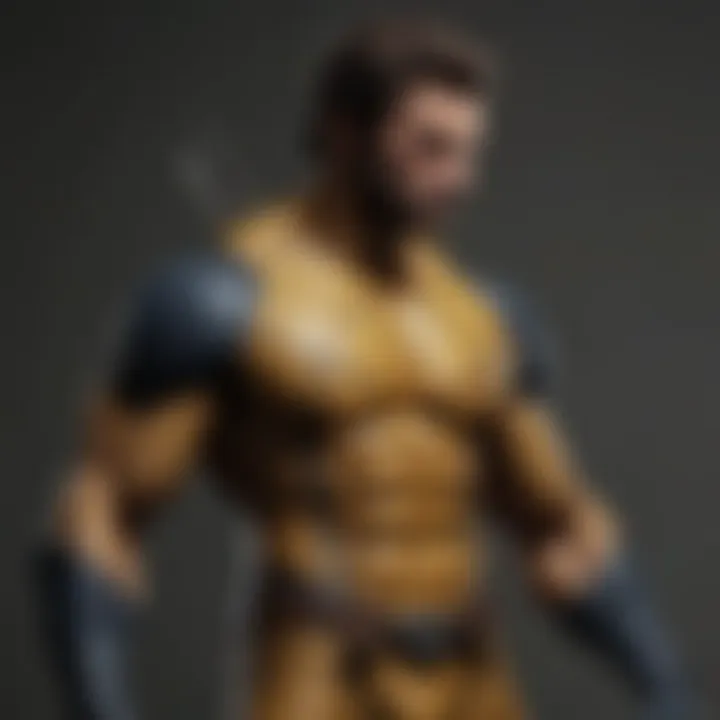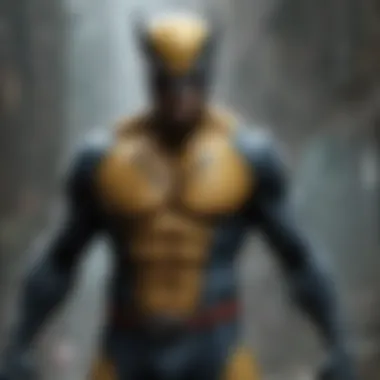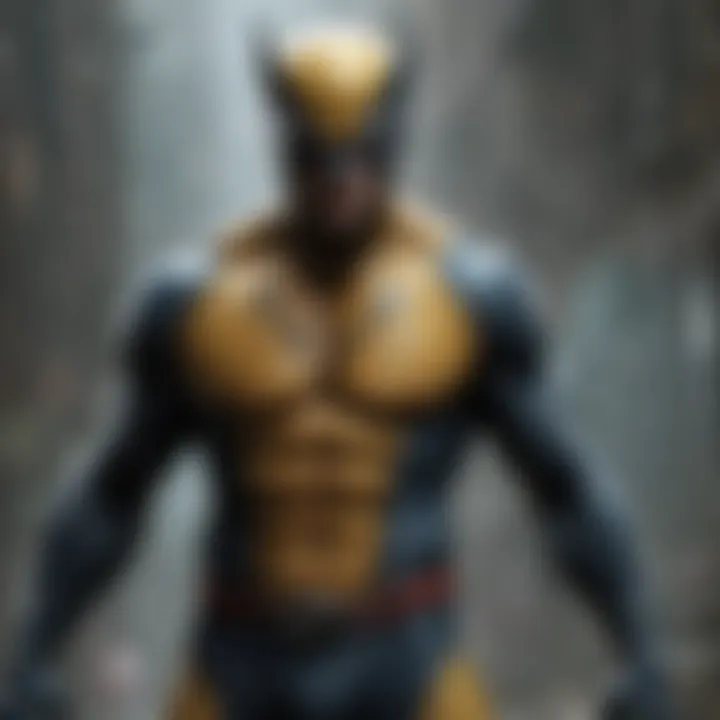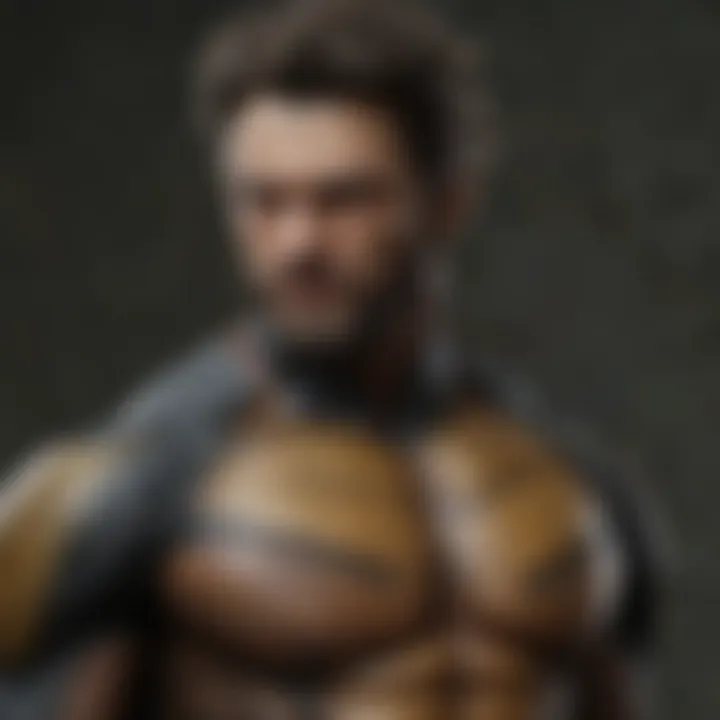Exploring Wolverine's Complex Duality in Marvel Universe


Intro
Wolverine, or Logan, is a character that stands out in the Marvel Universe. On the surface, he embodies raw power and primal instincts, yet he is layered with deep emotional complexity. This article aims to explore the duality of his character, analyzing how his animalistic tendencies clash with his human side.
Wolverine’s backstory reveals much about who he is. Born James Howlett in 19th-century Canada, he discovers his feral abilities after a traumatic experience. The inherent conflict between man and beast shapes his journey. His healing factor and adamantium skeleton make him nearly indestructible, but these powers often force him into situations where he grapples with his violent nature versus his conscience.
The relationships Wolverine maintains play a significant role in his character development. Connections to other heroes, like Cyclops and Professor X, underscore his struggle between ferocity and camaraderie.
In the following sections, we will delve deeper into the core of Wolverine's character by examining major themes such as his powers, lineage, and the cultural impact that surrounds this complex anti-hero.
Wolverine Character Analysis
Background
The evolution of Wolverine is pivotal in defining his character. Initially introduced in 1974, he was a side character in
Preamble to Wolverine
Wolverine stands as one of the most compelling characters in the Marvel Universe. His duality lies at the core of this complexity, where feral instincts intertwine with human emotions. To understand his significance, one must explore the layers that construct his identity.
This section explores Wolverine's role not only as a superhero but also as a representation of internal conflict. The mix of his animalistic motives against a backdrop of moral dilemmas presents a fascinating case study in character development. A profound examination of Wolverine reveals how his story mirrors broader themes prevalent in the narrative structures of popular culture.
Historical Context
Wolverine’s introduction in 1974 heralded a new era for comic books. Initially appearing in "The Incredible Hulk" #180, he combined traits of ferocity and depth. His background within the series provided scope for an examination of isolation, loss, and vengeance.
In a period when heroes adhered to binary morals of good and evil, Wolverine shattered those expectations. His storyline reflects shifting societal values concerning heroism, redemption, and understanding the darker aspects of human nature. Setting the stage, the emergence of Wolverine not only enriched the lore within Marvel but drew parallels to real-world struggles. This contextual framework serves pivotal to appreciating the character's evolution over decades.
Character Origins
Logan, famously known as Wolverine, claims Canada as his birthplace. Born James Howlett in the late 19th century, he possesses a tragic lineage with ties to Victorian narratives steeped in privilege and darkness. His transformation begins with a traumatic event; the brutal murder of his father ignites his animalistic side. This moment oddly blends his violent potential with human vulnerability.
To understand Wolverine wholly, one must consider his mutant abilities originating from the X-gene, contributing heavily to his identity as both vulnerable and invincible. The existence of his bone claws and later the lambent adamantium addition forms the crux of his hybrid nature. This combination delves into narrating not just fractures in the narrative such as pain, but positions him towards uncanny resilience.
In delving deeper, readers find the essence of Logan’s character: an obscure portrait of humanity portrayed through adversity and survival. Many layers to Wolverine exist, which this analysis aims to uncover fully, assuring a wide breadth of comprehension of the multifaceted dynamics at play.
The Man Behind the Mutation
The exploration of Wolverine's character begins with understanding the complex persona of Logan. This section sheds light on who he is beyond his superhuman abilities and feral nature. Comprehending Logan's life story adds depth to the themes of identity and duality within the character. With a rich narrative of personal struggles, it reveals how his past shapes his motivations and actions as Wolverine.
Logan: A Biography


Logan, known better as Wolverine, has a tragic and tumultuous biography. He was born James Howlett in the late 19th century in Canada, often carrying the weight of his family's expectations. Tragedy struck early; he witnessed his parents' deaths, which triggered the emergence of his mutant powers. Logan's claws, made of bone before they were coated with adamantium, are a symbolic representation of his pain and loss.
He spent his formative years struggling with his identity. Following incredibly traumatic events, Logan chose to embrace his primal instincts. Years of wandering and residing in multiple countries reflect a journey of self-discovery. Each experience renkering shaped Logan, leading him to safeguard the more vulnerable in society while grappling with inner turmoil.
Logan's life is fraught with conflict, offering rich layers, as he oscillates between violence and the desire for peace. This clash instills a significant aspect of his persona, depicting the never-ending battle between his human sesponses and animalistic instincts. Thus, understanding Logan's biography enhances one's grasp of Wolverine as more than just a superhero-
Background and Heritage
Wolverine's heritage is crucial when analyzing his character. He is a blend of Native American, Canadian, and European roots, marking him as truly unique within the Marvel Universe. His cultural amalgamation contributes to his complex identity, embodying themes of displacement and belonging. Various cultural influences shape Logan's perspectives on honor, strength, and sacrifice, often leading to internal conflicts.
Moreover, his ancestral background adds intriguing layers to his character. With family tragedies resolved through violence and a history intimate with pain and betrayal, it is no surprise Logan struggles to find solace. Traditional narratives within his family often conflict with Logan’s personal values, contributing to his dual identity. Certainly, one cannot dissect Wolverine adequately without considering his kin’s influence.
Wolverine's Powers and Abilities
Wolverine's powers and abilities are critical to understanding his character in the Marvel Universe. They not only define him as a mutant but also underscore the duality within him. His unique abilities contribute to his role as an anti-hero, blurring the lines between savagery and humanity. Comprehending these facets aids in appreciating his place in the larger narrative of the Marvel persona.
Regenerative Healing Factor
The regenerative healing factor is Wolverine's most iconic power. This ability allows him to recover from wounds that would be fatal to normal humans. Injuries such as bullet wounds, cuts, and even critical injuries can heal within moments, significantly extending his lifespan beyond that of an average human. Beyond mere survival, this power shapes his relationship with trauma, showing how he both embraces and struggles with the cycle of violence in his life.
Moreover, Wolverine's healing factor acts as a cheese against aging. His youthful appearance and vitality contrast starkly against his old and troubled past, creating complexity in his character. Such regenerative abilities responsibly craft much of Wolverine's story arcs in various mediums, giving context to his battles and losses, yet hinting at emotional scars that do not heal as quickly as his physical wounds.
Adamantium Skeleton and Claws
The fusion of adamantium into Wolverine's skeleton represents a significant defining moment in his life. Adamantium, a virtually indestructible metal, reinforces his bones as well as creates his retractable claws. This combination of factors ensures that he possesses unmatched physical strength and durability, establishing him as a formidable fighter in cosmetic of factors. The claws, powerful yet precise, brandish both Wolverine's savage potential and his capacity for controlled violence.
Additionally, the presence of adamantium highlights personal tragedy. The painful bonding process positions Wolverine in a position of victimization rather than a typical superhero. The physical enhancements, while beneficial, come at a cost of consequence and pain echoing his history of experimentation and manipulation. This duality embodies the core of Wolverine’s journey—a bitter mix of enhancement and torment.
Enhanced Senses and Animalistic Instincts
Wolverine's enhanced senses distinguish him as more than just a brawler. His heightened hearing, superior sense of smell, and acute vision grant him abilities akin to those of wild animals. These enhanced faculties not only augment his combat skills but also shape his instinctual responses. His predator-like tendencies make him profoundly empathetic to the feelings of danger or threat, often leading to a morally more raw approach than other heroes.
This animalistic nature intertwines with his more humane qualities, creating emotional depth and a profound inner conflict. It questions the boundaries of morality, contrasting his introverted moments with his primal urges. Wolverine’s struggle showcases a persistent balance between embracing and repressing his wild instincts—a narrative facing the core of what it means to be human while existing between two worlds.
Through these powers, Wolverine transcends the typical narrative of superhuman strength and instead delves into deeper philosophical inquiries about existence, humanity, and morality.
Relationships Within the Marvel Universe
Wolverine's place within the Marvel Universe is vastly defined by his relationships with others. These connections underscore the character's complexity and showcase how his dual nature plays out in varied contexts. Each relationship contributes to our understanding of Wolverine as not just a formidable mutant but also a deeply human character. Analyzing these relationships provides insights into how he navigates both alliances and conflicts amid the often turbulent landscapes of superhero interactions.
The X-Men Team Dynamics
Wolverine is one of the prominent members of the X-Men, leading to intricate dynamics within the team. His often gruff approach contrasts sharply with the more idealistic views held by other characters such as Cyclops and Professor X. Despite his initial reluctance to embrace it, he finds a sort of family within the team.


- Charles Xavier guides Wolverine toward a purposeful application of his foundational abilities.
- Cyclops represents order and discipline, clashing with Wolverine's instinctual, wild nature.
- Jean Grey, holding unique bonds with both men, cultivates a rivalry steeped in tension but also a mutual respect.
Wolverine’s role among the X-Men evolves into that of both protector and maverick. As he grapples with the team's collective values, his duality manifests—struggling between the urge for independence and the complexity of belonging.
Rivalries and Conflicts
Conflict often emerges in Wolverine’s relationships, and rivalries serve to further flesh out his character. A primary antagonist is Sabretooth, whose rivalry with Wolverine dates back to their shared history and makes their encounters bitterly personal. This animosity is built on a foundation of mutual recognition of each other’s ferocity and effectiveness in combat. Sabretooth embodies everything Wolverine has fought against in his quest for identity and control.
Moreover, Wolverine's tug-of-war with other members shapes his persona.
- One infamous conflict with fellow X-Man Hank McCoy, or Beast, serves as a reminder that intellect can often clash with primal instincts.
- Wolverine's grapple with Magneto anchors yet another layer—a fight between ideals regarding the future of mutants.
Observing these rivalries highlights how overarching themes in Wolverine’s life impact his inner conflict, balancing might with method and intention.
Love Affairs and Emotional Ties
The emotional connections that Wolverine fosters also foreshadow part of his struggle with his duality. There are key figures who have influenced him profoundly—most notably Jean Grey and Mariko Yashida.
- Jean Grey symbolizes an ideal; their complicated, often tumultuous relationship navigates the chasm between love and loss.
- Mariko Yashida, a Japanese woman with whom Wolverine has shared a romantic entanglement, presents contrasting cultural and emotional landscapes that test Wolverine’s stillness versus his feral instincts.
Aside from romantic involvements, friendships with characters like Kitty Pryde display a more platonic but equally important bond. Kitty represents hope to Wolverine through her younger outlook on life, making her sparks of joy crucial amidst his darker considerations.
These complex romantic and platonic relationships channel Wolverine's internal conflicts and showcase the many facets of love and loyalty within the broader superhero discourse.
Ultimately, Wolverine’s ties to others in the Marvel Universe create a fabric through which his rich character is woven. They allow for exploration above the surface-level idea of heroism, revealing the poignant depths of love, conflict, and the challenge of defining oneself against myriad external expectations.
Wolverine in Pop Culture
Wolverine's role in pop culture extends far beyond comic books. His character, a mixture of grit and depth, has influenced media, merchandise, and even academic discourse. In exploring Wolverine's impact, it's clear that he embodies a specific duality—a tortured soul striving for redemption in a brutal world. His significant presence in films, television, and video games illustrates this complexity and reflects broader societal themes.
Film Adaptations
The cinematic representations of Wolverine have been pivotal in conveying his multifaceted nature. The films starring Hugh Jackman have brought Wolverine to mainstream audiences, starting with X-Men in 2000. Jackman’s portrayal ranges from menacing to sympathetic, adding new layers to Logan's character.
The film franchise not only showcased Wolverine's physical prowess but also offered glimpses into his emotional struggles. For instance, in Logan (2017), we witness an aging Wolverine grappling with loss and despair. This film stands out for its raw narrative, diverging from the typical superhero tropes to explore themes of mortality and legacy. Each adaptation offers fresh interpretations, delving into his relationships with characters like Professor X and Jean Grey, further solidifying his place in cinematic history.
Key Films to Consider
- X-Men (2000)
- Logan (2017)
- The Wolverine (2013)
These adaptations reflect Wolverine's evolution over the years, resonating with audiences on a personal level.
Television Appearances


Wolverine's television appearances provide vital context for understanding the character's appeal. The X-Men: The Animated Series, first aired in the 1990s, became a cultural phenomenon. It portrayed Wolverine as both a soldier and a maverick, depicting his conflicts within the X-Men universe. The show's narrative depth contrasted sharply with many contemporary animated series, highlighting intricate character development.
Later series such as Wolverine and the X-Men further explored Wolverine's leadership and emotional vulnerabilities. In each portrayal, audiences see a more layered figure grappling with issues of responsibility, friendship, and internal conflict designed to captivate viewers both young and old.
Video Game Representations
The gaming world has also embraced Wolverine, allowing fans to interact with his character in diverse formats. Notable games such as Marvel vs. Capcom series and X-Men Origins: Wolverine not only offer thrilling gameplay but also delve into his history and nature as an anti-hero. These representations allow for exploration of various aspects of his identity, from his primal fury to limitations in controlling it.
Noteworthy Games
- X-Men Origins: Wolverine (2009)
- Marvel’s Avengers (2020)
- Marvel vs. Capcom: Infinite (2017)
These games contribute to an understanding of Wolverine’s character by adapting comic book stories, promoting relatability and engagement through a participatory experience.
Wolverine's adaptability across different platforms showcases his relevance in popular media and explains his lasting impact.
In essence, Wolverine's presence in pop culture is a reflection of societal themes such as struggle, resilience, and the search for identity. His constant evolution, particularly in film, television, and video games, mirrors contemporary cultural narratives, ensuring his significance for future generations.
Philosophical Implications of Wolverine's Duality
Wolverine represents a deep philosophical dichotomy within comic book narratives. His character embodies the struggle between primal instincts and convoluted morality. Analyzing Wolverine allows us to explore complex ideas that inform human behavior. This section will delve into two pivotal philosophical themes illustrated through Wolverine's life and actions: the good versus evil conflict and the nature of humanity. By examining these themes, we can assess how Wolverine mirrors real-life dilemmas.
Good vs Evil
The character of Wolverine grapples consistently with the concept of good and evil. On one hand, Logan possesses experiences that lead to acts of violence, driven by his animalistic instincts. This core part of his personality invites questions about his morality. Logan has committed acts that are harsh, often thrust into conflict due to circumstances, whereas on the other hand, he frequently showcases limited benevolence and sacrifice for others, particularly within the X-Men.
While he functions as a feral entity, driven by primal urges, he retains fragments of decency. Wolverine's personal battles reflect the eternal query facing humanity: Can someone be innately good if they engage in evil acts? The multitude of his decisions and existential fears supports an understanding that emphasizes morality as a spectrum, without stark divisions.
“Wolverine's story challenges our perception of heroism; is he a hero because of his good deeds, or the circumstances that drive him into conflict?”
In various story arcs, his conflicts with Sabretooth further emphasize those moral inquiries. Sabretooth sees strength in embracing chaos and hostility, while Wolverine attempts to reconcile with his own darkness. They become foils, symbolizing the juxtaposition love and hate holds within a battle against inherent nature.
The Nature of Humanity
Also, Wolverine serves as a lens through which we examine the nature of humanity. Reflections on his character prompt thoughtful discussion about the balance between instinct and reason. His experiences preclude him from full acceptance in either human or mutant societies. This alienation raises questions about what truly constitutes humanity. What does it mean to be human when primal drives conflict with societal norms?
His healing factor can symbolize resilience in humanity’s dark times. Often, Wolverine's tenacity is a metaphor for enduring human suffering and the ability to heal, both literally and emotionally. Instances of him overcoming great losses showcase how he confronts traumas, leading to existential questioning.
- Is survival enough if it leaves them bereft of their morality?
- What does redemption look like for someone with a profound past like Logan’s?
Wolverine not only fights physical foes but battles inner demons as well. His journey illuminates deep constructs, providing opportunities to reflect on the inherent impulses within everyone. Ultimately, these explorations serve to maintain our grasp on philosophical constructs far beyond comics, filtering into our understanding of what it means to be alive.
Closure: Assessing Wolverine's Legacy
The legacy of Wolverine is significant in the discussion of comic book narratives. He embodies the relentless struggle between his intrinsic feral nature and his humanistic values. This duality makes him a character that resonates not just with fans of comic lore but with a broader audience.
His narrative arcs often invite reflection on morality. Wolverine grapples with concepts of vengeance, sacrifice, and duty. This internal conflict adds depth to his character that is absent in many heroes who do not face such duality. Dorfman argues that Wolverine amplifies the philosophical ramifications of choices made when the lines between right and wrong blur.
“Wolverine stands as a reflection of humanity's darker impulses entwined with the quest for redemption.







